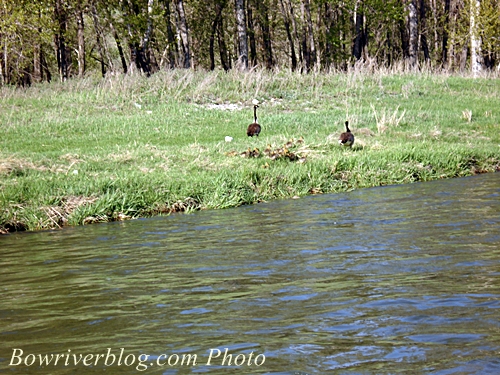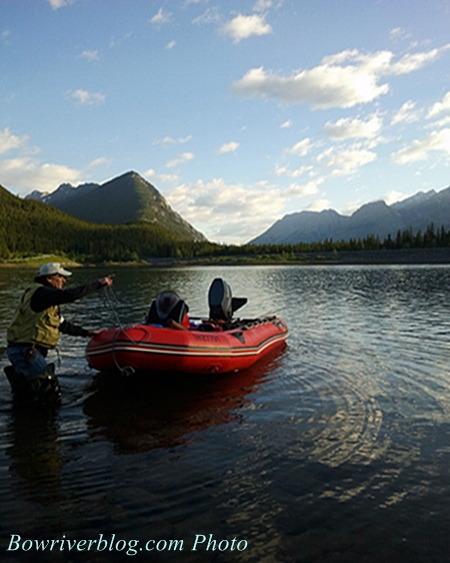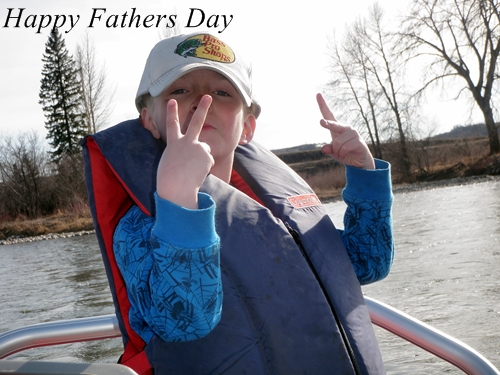Summer Fishing Fun!
It was cool in the morning as the sun peeked through the thick mist rising off the river. My clients David, Jeff and I pulled into Policeman’s Flats at around six thirty in the morning. Surprisingly there were several vehicles there and just starting to launch out when we pulled in. As we waited to launch we tied our hooks and prepared for the feeding frenzy. Our turn came to launch and we were off into the mist that had not burned off the river. Another picture perfect moment to begin the day! The shutter closed as I rowed the boat to the opposite bank we launched from. A few moments and the Rapala’s hit the water. The top portion of the float was a little on the slow side, therefore only a few bites and no fish landed. Shortly after we put in, I pulled the boat off the river to do some shore fishing in a nice riffle that came off the point of the north bank. Since David does not own a boat, I wanted him to learn how to fish off the banks. He is a local Calgarian and wanted to learn the secrets of the Bow River.
We were casting the Rapala Countdown upriver and reeling quickly to keep the lure down on the river bed. The water was stained from the rain we received the previous day, thus I wanted the lure to make bottom contact and then be lifted up and reeled back into the bank. I explained to David and Jeff that the trout will usually hit after the turn in the cast. As the lure passes directly in front of you and then makes the turn, that’s when you will hook up. On David’s fifth cast a rainbow did just what I was explaining. This is the fish you see in the picture above, not the biggest fish on the day but the first one to be hooked and released. Then it was Jeff’s turn, he was casting a Rooster Tail in white color and landed a very decent rainbow in the same location David caught his. We then moved down river as you do not want to fish in one spot too long. It’s better to pick the river apart then stand in one spot for to long. I looked over my left shoulder and David was scrapping another sweet male rainbow. Three nice fish and we were back in the boat casting to the next fish.
A short drift around the corner and it was time to pull off the river again. This next hole we fished usually produces monsters. I wanted to see a monster on David or Jeff’s line. No monsters but a few good looking rainbows were landed. “The big fish are in the deep holes” I stated. “Lets try the spinner for this long shallow stretch and then we will use the crankbaits in the next deep hole”. Sure enough when we arrived in the next deep hole there was a big fish hooked. I asked Jeff to cast over a seam and reel the Rapala through. Rod tip down, lift the tip up to make the lure swim erratically. As soon as Jeff lifted the rod tip, a massive brown munched down on his lure. Awesome fish it was! Jeff was happy and it made my day as well. I helped David and Jeff read the river and by the time we were almost finished the trip, both David and Jeff were casting the Rapala exactly where I was looking. No further instruction was required on my part.
Before the end of the trip was near, I pulled the boat into a back bay just before MacKinnon Flats to let them catch “just one more”. I can’t tell ya how many times I have said that while fishing. David rifles his hook into the back beside some big boulders, reels in while pumping the rod and a 23 inch rainbow is locked in.
“Nice fish David, that’s the kind we are here for” as we exchanged a high five. We ended our trip on a great note, a 23 inch note! It was the perfect day for fishing. Nice weather combined with nice fish. I look forward to the next time we fish the Bow River together.




